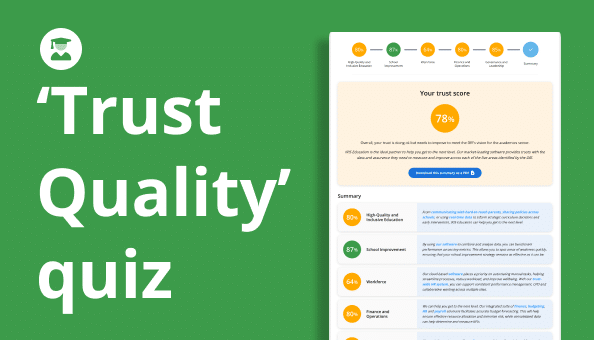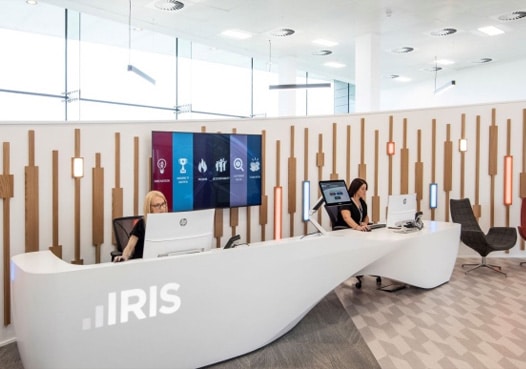How to evaluate the transition to Cloud MIS
Updated 29th December 2022 | 7 min read Published 14th February 2022

The technology exists for educational MIS tools to make the essential move away from desktop and into the cloud. However, a staggering 70% of school IT systems (consisting of MIS software and data hosting) still run on desktop solutions that are essentially locked away in a room. While these tools may be deemed adequate by some, their desktop nature means educators cannot benefit from connected and real-time data.
Being tethered to desktop MIS software has many limitations, including having to use valuable resources to host, manage and secure the systems. The old ways of running schools kept data out of the hands of the people who needed it and has created a significant admin burden for teaching staff today, who have to duplicate data entry across different systems.
Educators do not have the ability to quickly fulfil the information needs of stakeholders (i.e. governors, parents, pupils, teachers) and waste considerable time trying to organise data into something meaningful.
The technology exists to bring real-time MIS data together into a connected cloud system. Absence data can be collected at registration and dealt with in real-time. Every teacher has a central, holistic view of each child and can join up the dots on changes in behaviour, wellbeing and safeguarding. Attainment and progression can be contextualised and even scrutinised taking other factors into account. Educational leaders are able to look ‘at’ and ‘for’ trends in the numbers.
Preconceptions around technological change are that it is scary and hard. However, schools that have already made the switch successfully demonstrate the many practical actions that can be taken to make the process as painless as possible. Here’s four principles to consider.
Adopt a simple change management mindset
It’s easy to get caught up in complex change management models and a mindset of feeling the need to hire expensive consultants when switching. However, the successes of those who have already made the move to the cloud prove that it is possible to take more pragmatic and cost-effective steps to managing change.
Create collateral to support internal communications, building a champion group to evangelise about the change and providing learning opportunities for team members. These are powerful and straightforward actions that can be taken to ease cultural fears and get the process on track.
Champion groups should be formed from across an entire school or MAT and comprise a diverse range of people rather than just early adopters and power users. These individuals will be ambassadors, so they should be involved in decisions and given appropriate bandwidth to perform their champion role.
It is the softer side of change that is important to get a handle on, which is why internal communications plays a pivotal role. Have a clear communications plan with a regular drumbeat of outreach using a variety of different mediums. Cloud MIS vendors are starting to support schools with these vital internal communications efforts. Some provide posters, tutorial-style videos and raise awareness. These focus on the benefits at an individual level.
Internal communications vehicles can also be used to celebrate successes and achievements during the transition. This is a great way to motivate stakeholders to try new ways of doing things and reinforce the necessity to change. If there are fears around change, this should be dealt with head-on through two-way communication and engaging everyone in decision-making. This provides opportunities for concerns to be discussed honestly.
Promote your tech usage as a differentiator to staff
Teachers are drawn to the profession to inspire and teach students, not to fulfil admin requirements. The UK is facing the largest skills shortage for generations. According to ONS’s latest labour market statistics, recruitment difficulties are persisting as open vacancies rocket to record highs. Employers are having to fight harder for every candidate, and no one wants to lose quality teaching staff. If a teacher has been empowered through modern technology before, they will be horrified to have to revert back to a desktop world of work.
Sticking with desktop technology may therefore make it harder to retain key staff and attract younger teachers, who may be digital natives themselves and are likely to be more aware of what cloud technologies can bring.
Cloud-based systems offer internal messengers, planners and registrations while tools like voice-to-text dictation remove the pain of term-end reporting. Live notifications mean no more needless notes, errands or calls and vendors are working hard to deliver a superior, consumer-grade user experience; the standard younger generations now expect in all aspects of their daily lives.
Supplier choice – look for technology and support
Choosing the right school MIS is key to dealing with the scale of the task. Fully explore with them how the new solution will work in practice. For example, it should support ease of use, streamline workflows and provide access for all stakeholders. It should also connect data silos, providing a rich flow of information throughout the school and a real insight into what is going on. Schools generate a great deal of information and school leaders need to have this information in their hands, in an easy-to-consume format.
In the case of MATs, where infrastructure around change is likely to require diverting critical people’s time, and in worst-case scenarios, educators away from what they are supposed to be doing, it is essential to get the planning right. Choose a technology partner capable of supporting you through this. One that has the resources to take the role of change management hand holder.
Vendors should also have the experience and scale to bring in resources to support implementations, especially if requirements change or something doesn’t quite go to plan.
Let your IT Support Provider do some of the heavy lifting
You don’t have to go on the journey to changing vendors on your own. IT Support Providers play a key role in supporting schools in evaluating their options. They have deep expertise and provide advice as well as high-quality support.
Working with these providers allows schools and MATs to benefit from knowledge across the whole community. They have a great skill set and a wealth of users stories to draw on.
MIS Support Units like SBS and iCT4, for example, are on a quest to transform the classroom through technology. Computeam is another organisation that Schools and MATs trust to deliver future-proofed, cloud solutions that make a positive impact on school life, whether in the classroom or outside of it.
It can be riskier to stay as you are
The demands on teaching staff and governors are increasing, so there is an opportunity cost to not moving to cloud MIS software. Indeed, our recent data shows that 90% of schools are expected to do more with less funding.
There is no doubt that the pandemic has further exacerbated the admin burden on teaching professionals who must report on increased absence, deliver lessons remotely and play a more active role in the pastoral care of students; all alongside fulfilling Ofsted and School Workforce Census requirements.
Cloud MIS tools free up teachers’ time so it can be spent on the things that matter the most; the students. To me, this offers schools the ability to change their whole environment; picking out those repetitive, non-value-added tasks and giving time back to teachers. The wider societal impact this could have is huge.
The requirement of MATs and schools having to analyse data to provide insights about the performance of pupils and operational effectiveness is also a particular challenge. 43% of teaching staff list this as the most significant issue they currently face and 90% of school leaders now say report data and analysis is a huge issue impacting their workload.
Remaining on desktop solutions makes data analysis harder, with educators having to use valuable time moving around sensitive data manually. We don’t want to see schools manipulating data in spreadsheets when there is such a powerful alternative.
The richness of data that cloud software brings ranges right across the school day, from joining the dots on pupil safeguarding concerns in real-time, through to maximising school assets. The ability to host this data in the cloud, and then interrogate it quickly and easily, means that those schools without this capability will be left with a huge disadvantage.
Revolutionising schools and MATs with IRIS Ed:gen
If you're looking to make a software switch, check out our next-generation MIS, IRIS Ed:gen. Designed for state schools and ideal for trusts, primary and higher education settings, IRIS Ed:gen lets you harness the power of real-time data.





